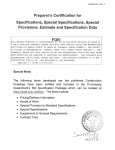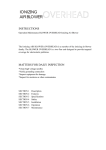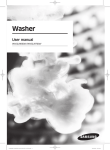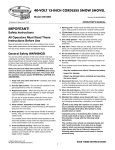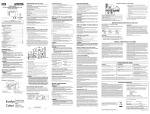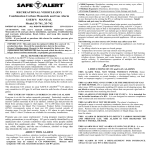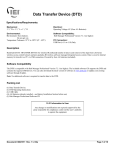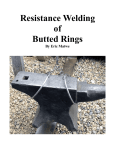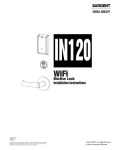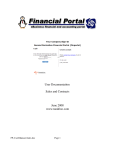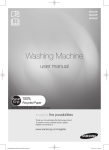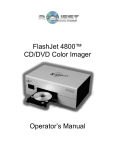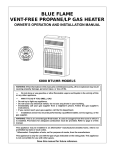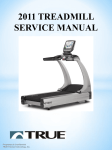Download Owner`s Manual/Warranty - Rich`s Portable Cabins
Transcript
OWNER’S MANUAL Rich’s Portable Cabins Your decision to own a Rich’s Portable Cabin is going to allow you the freedom to enjoy the quality, durability and performance that others have for the last twenty years. This manuals sole purpose is to give you instruction on the proper operation and maintenance of your cabin. Although most factors are common in all of Rich’s Portable cabins your specific cabin may or may not have all features outlined in this manual. This manual is meant to be reference and not a complete guide to all matters relating to your cabin. This manual does not represent any warranty, neither expressed nor implied; the only warranty by Rich’s Portable Cabins is set forth in the limited warranty applicable to your unit. Read and refer to all manufacturers’ documents associated with your appliances. The Limited Warranty and limited warranties issued by the component manufacturers stipulate periodic service and maintenance. Failure by the owner to provide such services and/or maintenance may result in loss of warranty coverage. The owner should review Rich’s Portable Cabins limited warranty and those of component manufacturers associated with the product. Component manufacturers’ literature should take precedence if information or instructions differ from this manual. Thank you for your business! Rich Daniels Rich’s Portable Cabins www.richsportablecabins.com 541-898-2444 1 Manual Contents Warranty Information ......................................................................................................................4 Appliances and Equipment ..........................................................................................................6 -General Information -Refrigerator -Water Heaters -Range -Range Hood -Microwave Oven -Air Conditioner -Furnace -Safety Equipment -Dishwasher -Washer -Dryer -Fireplace Electrical Systems ............................................................................................................................8 -General Information -Circuit-Breaker Panel -Power Supply and Voltage Awareness Gas System ........................................................................................................................................9 -General Information -L.P. Gas and Safety Precautions -Repair or Replacement of Range or Dryer Plumbing System ...........................................................................................................................12 -Water Heater -Winterization -De-Winterization -Waste Water System 2 Care and Maintenance ................................................................................................................15 -General -Facts about Mold -Metal Roofs -Seals and Adhesives -Stains and Paint -Vinyl Windows: Exterior -Vents, Doors and Screens -Countertops -Faucets and Fixtures -Flooring: Carpet -Flooring: Vinyl -Flooring: Laminate -Flooring: Hardwood -Glass and Mirrors -Paneling and Cabinets -Sinks and Toilets -Windows: Interior -Bathroom Tubs and Showers Appendix ............................................................................................................................................19 3 Warranty Information Warranty Coverage Rich’s Portable Cabins, Inc. (the “Manufacturer”) provides to the original owner (the “Consumer”) who purchased this new RPC (Rich’s Portable Cabins) cabin on a One-Year Limited Warranty from the date of delivery of the cabin to the Consumer that, except as to the exclusions listed below, the cabin is to be free from substantial defects in materials or workmanship. The warranty is not transferable in any part and only applies to the cabin at the initial set-up site. The Consumer is responsible for performing the normal maintenance as described in the Homeowner’s Manual. All warranty claims are subject to a $100 deductible. Manufacturer’s Obligation The Manufacturer’s sole obligation under this Warranty and the Consumer’s exclusive remedy shall be limited to repair or replacement of any part(s) which may prove to the Manufacturer’s satisfaction to be defective within the one-year term of this Warranty. Procedure for obtaining warranty performance If a problem occurs which the Consumer believes is covered by this Warranty, written notice in sufficient detail to describe the alleged defect must be given to RPC within the one-year Warranty period. Warranty Exclusions This Warranty does not cover the following: • Any damage resulting from misuse, neglect, accident, acts of God, or unauthorized repairs or alterations of the cabin. • Any defect or nonconformity caused by the unauthorized or unreasonable handling or use of the cabin subsequent to the date of purchase, including, but not limited to damage caused by improper leveling, set-up, re-leveling, or transporting of the cabin from the Dealer to the Consumer’s site. • Any appliances, plumbing fixtures, furniture, drapes, bedding, flooring covering, light bulbs, equipment, or other components that are not manufactured by the Manufacturer and/or are separately warranted by other manufacturers. • This Warranty shall not include the set-up of the cabin. • This Warranty shall at once be null and void when this cabin is moved from the site of initial set-up or is used for commercial or other income producing purposes. Limit on Implied Warranties and Consequential Damages The Warranty provided herein is in lieu of all other express warranties. Implied warranties, including those of merchantability or fitness for a particular purpose, are limited to one year from date of 4 purchase and, to the extent permitted by law, and and all implied warranties are excluded. All other obligations or liabilities, including liability for incidental or consequential damages on the part of the Manufacturer and the Dealer, are hereby excluded. Some states do not allow limitations on how long an implied warranty lasts or do not allow the exclusion or limitation of incidental or consequential damages, so the above limitation or exclusion may not apply to you. This Warranty gives you specific legal rights and you may also have other rights which vary from state to state. If the Consumer lives in Idaho, Florida, New Mexico, or Wisconsin they are directed to these variations as shown below. Entire Statement Except as expressly contained herein, there is no other Warranty of any kind or nature. The Manufacturer assumes no liability nor responsibility for any representations or stipulations by dealers, agents, salesmen, representatives, employees or any other person, other than those expressly contained in this Warranty. State Variations Idaho This Limited Warranty applies to the structure, plumbing, heating and electrical systems and all appliances and other equipment installed or included thereon by the Manufacturer. Florida This Limited Warranty applies to all structural elements, plumbing systems, heating, cooling and fuelburning systems, electrical systems and fire prevention systems. The Manufacturer also warrants that the cabin contains 100 amp. electrical service. New Mexico and Wisconsin This Limited Warranty extends only to the original and any subsequent owner of this cabin during the time of this Warranty. This Limited Warranty covers all appliances and equipment installed in the cabin by the Manufacturer unless the Manufacturer furnished a valid Warranty from the make or dealer of such appliances and equipment. I acknowledge that I have read and understand this Warranty as to what it does and does not cover. Customer Signature___________________ Vehicle Identification Number_________________ For All States Except California 5 Appliances and Equipment General Information The following instructions are general in nature and may vary depending on the exact appliances that you have in your Cabin. Please refer to the individual owners manuals that are supplied with your cabin for detailed information on your specific appliances. Please review each manufacturer’s individual owners and information for their warranty procedures. You must complete and mail all owners registration for individual warranty items. It is important that you read carefully each manufacturer’s operations and maintenance requirements and if they differ from information provide in this manual please follow the guidelines spelled out in the individual manufacturer’s literature. This manual provides general tips that are not specific to any appliance. Refrigerator The refrigerator and freezer should be set to 5 degrees during initial startup and operation. After the refrigerator has ran for 12-24 hours and has been allowed to cool the temperature should be set to desired temperature. Allow 12 hours after each adjustment for the refrigerator to reach desired setting. If your refrigerator is equipped with an icemaker or water please follow the directions in the specific owner’s manual for winterization instructions if necessary. Water Heaters The water heater is filled automatically when the cabin is hooked up to a water supply. Make sure the water heater is filled before lighting or heating with electricity, otherwise the heating element may be damaged. Read all literature regarding hot water heater before using paying particular attention to safety precautions and warnings associated with its use. Range Never leave the range unattended when lit. Lighting of Natural Gas or Propane burners. Gas and Propane ranges are equipped with an electric or spark ignition system. Make sure that the gas or propane supply is turned on with lighting. 6 Rangehood/Microwave The exhaust fan filter should be replaced annually. Make sure the fan is turned off when replacing filter. The microwave should not be adjusted or repaired by anyone other than a qualified technician. Microwave Make sure that the turntable is in place properly (when applicable) and the turning radius is not restricted. It is important that you choose the proper power levels for the foods that you will be cooking. The microwave should not be adjusted or repaired by anyone other than a qualified technician. Air Conditioner (optional) Air conditioning requires a substantial amount of the power supply available to the unit so efficient operation is an important consideration. Efficiency can be helped by closing all doors and windows. Furnace Your furnace is vented to the outside with an exhaust vent. Never store anything in the furnace compartment or on the outside in front of the exhaust vent. Have the entire system checked annually by a qualified service agency for efficiency and safety. If you suspect a problem with your system immediately contact a qualified service agency. Safety Equipment The best way to reduce the risk of fire is through prevention. Please follow the manufacturer’s instructions for use of all appliances and observe all safety precautions and instructions included. Smoke Detector All Cabins are equipped with smoke detectors. Smoke detectors should be checked regularly for functionality. Gas Detector Please see the gas section of this manual. Dishwasher (optional) The filter combination must be emptied and cleaned regularly. If function deteriorates noticeably, the spray arm should be checked and cleaned. Providing the correct type of detergent is used and operated correctly the dishwasher does not need any special care as it is cleaned through daily use. The rubber seals around the dishwasher need to be inspected and cleaned regularly with a damp cloth to remove food residue. 7 Refer to the specific owner’s manual if for operation and maintenance instructions as well as if winterization is required. Washer/Dryer (optional) Washer Water-fill hoses should be checked for cracks or weakness periodically and most manufacturer’s recommend replacement after 5 years. If the washing machine is not level it may vibrate and move, The adjustable legs on the bottom should be used to level the machine. Use a damp rag to clean its surfaces. Most washing machines collect lint during the cycle and send it down the drain. If your machine has a lent collection area it should be checked and cleaned after each use. If winterization is necessary please refer to specific manual for instructions. Dryer The lint produced by tumbling in a dryer is usually collected in a lint tray. The lint filter should be cleaned after each use. If there are any rips or tears in the filter it should be replaced. At least once a year check the entire length of your vent and clear it of any lint or debris. Fireplace Gas fireplaces are clean burning and require very little maintenance. An annual inspection by a qualified individual to inspect the burner, fan, pilot light, venting and thermostat and even the glass is recommended. Check with specific manual for tips on cleaning the glass. Typically normal glass cleaners are not as effective as cleaners meant specifically for fireplace glass. Electrical Systems General Information The electrical power supply is designed to operate with a 110V, 120V or an optional 120/240V power supply. When the 110V system is operational it allows for all functions inside the cabin. Circuit Breaker Panel The electrical system is protected by circuit breakers that automatic shut off if the system is over-loaded or a short circuit occurs. If the circuit breaker is tripped do not reset until the problem has been corrected by a qualified electrician. 8 Power Supply and Voltage Awareness Voltage too Low (Incoming service to your cabin) Periodic Low Voltage or fluctuations from your power supply may affect performance and be the reason for unexplained difficulties or failures. Items under warranty would not be covered for problems created by Low Voltage problems. Equipment that may be affected by Low Voltage Microwaves, televisions, computers, any appliance that is motor driven such as furnace fan and air conditioners. If your power supply is subject to Low Voltage you will have to learn to operate under those circumstances. Only you can control the power through your main cord. This can be achieved by coordinating the times and usage that you turn your appliances on. NOTE: Your cabin is required by code to protect against EXCESS AMPERAGE DRAW, if you plug too many things in your circuit will “break.” Unfortunately there is no protection for an insufficient power supply. An obvious sign for Low Voltage or High Amperage Draw is a sudden change in the lights. If you know or suspect a problem in your voltage it can be checked by an electrician. A voltage meter can also be put on if you suspect a continuous problem. The meter will allow you to regulate your use accordingly. Voltage too High (Spikes and Surges) We are all familiar with surge protectors for use with our laptops and computers but the same can be used to protect all of our electronic equipment. Utility suppliers and some insurance companies deny claims based on spikes or surges. Buy good quality sensitive surge protectors to protect all electronics in your Cabin. Gas System General Information Your Cabin is equipped with either a propane or natural gas system that is designed to work clean, safe and efficient when the properly maintained and safety precautions are observed. Both types of systems are historically safe but need to be treated with respect. Both systems should be hooked up at time of installation by a properly licensed professional. CAUTION • Natural gas is lighter than air and is highly flammable. • LP gas is heavier than air and will settle into low areas. • Both give off a noxious odor from additives. 9 • In a confined space both are highly explosive. • An improper combustion setting burns more oxygen from the interior air available to the occupants. • Your Cabin is provided with functioning windows and vents. You must leave one or more of these open a small amount as a safety precaution to provide external combustion air for same appliances and fresh air for the occupants. • Never use your range or stove to provide heat for your Cabin. • The use of space heaters (non-electric) is not recommended and may not be safe. Gas Leaks: If the smell of gas is present in your cabin no matter how faint: • Open all doors and windows to let fresh air circulate. • Check all appliances to see if they have been left on and pilot lights to see if the flame has been extinguished. • All appliances should have shut off valve for gas. Make sure all are closed. • If the leak is appliance specific, have a qualified professional repair. • If the smell gets stronger or you hear a hissing leak, leave immediately. • Upon leaving make sure front door is left open. • Call your gas company immediately for shut off. DO NOT: • SMOKE OR STRIKE A MATCH. • OPERATE ANY ELECTRICAL SWITCHES. • OPERATE A FLASHLIGHT OR LIGHTER. LP Gas Safety Precautions: The liquid petroleum (LP) gas system in your unit is a safe, clean and efficient form of energy when safety precautions and instructions are followed. The gas is stored in a highly pressurized container and pressure is decreased as it goes through your regulators into your appliances. The regulator has been preset by the manufacturer and should not need adjustment. Should adjustment be needed do not attempt to adjust it yourself. Adjustments must be made with special tools by a qualified LP technician. Have your regulator checked annually. Because the regulator requires air to operate make sure it is kept clear of dirt and debris. Your LP system is designed to accept propane. Because LP can be dangerous if not handled correctly here are some basic safe practices. 10 1. Have your tanks filled at authorized or licensed LP gas station or service. Proper purging of an empty tank will ensure correct fuel consistency and purity. Tanks are designed for maximum fill levels, typically 80% max. with 20% vapor space. There are aspects of filling or refilling which should be done only by qualified persons. 2. Propane hoses have counter-clockwise rotating threads to tighten to tank. 3. Check all tank line connections each time you fill or change over the two stage regulator to be sure they are tight. When testing for leaks use soapy water and watch for bubble formation. Do not test with a lit match! 4. Under no circumstances should the LPG regulator be adjusted, except by an authorized or licensed LPG service person. 5. When transporting tanks for refilling, secure them against falling or rolling. Never transport, install or store any propane tank inside your cabin. 6. Never install a lock or device requiring a key or impedance to opening the storage location of the LPG tank or the operation of the valve should emergency access and shut-down be required. 7. Never use an upright tank in the horizontal position, or lay down as an upright tank. Tanks are designed to draw vapor off the top of the liquefied gas. Drawing liquid into your system and appliances must be avoided. 7. It is recommended that the system is shut off at the tank during unit transport or relocation. 8. If an odor of gas is present, do not light any of the appliances until the leak has been professionally repaired. 9. Practice safety at all times. If you have any questions about the operation of your appliances or the LP system, contact your dealer or your local gas service provider or licensed technician. 10. Your LPG system has been designed and tested under factory controlled conditions and the applicable codes and regulations. Do not modify the system. 11. Do not use rusted supply tanks or fill tanks which are beyond their regulated term of service life. 12. Always have adult supervision when children are involved with any matter dealing with the LPG system. 13. Make sure appliances are off prior to turning system on at tank. Read and refer to all manufacturers’ literature associated with your LP-Gas fuelled appliances. The manufacturer’s literature should take precedence if information or instructions differ from this manual. This information is not intended to be a complete reference to all matters relating to LP-Gas and appliances. Propane gas system start-up, use and refilling should be done with care and caution, respecting the characteristics of the fuel, appliances and procedures required. Repair or Replacement of Range or Dryer In the event that an appliance such as a range or dryer is disconnected for repair, the service representative should be aware of the following: • Park Model units with propane do not have individual shut off valves at each appliance. Prior to any disconnect the gas source must be shut off to the entire unit. 11 • Park Model units connected to natural gas are required to have individual shut off valves at each appliance. The individual appliance can be disconnected when the valve is turned off. It is the responsibility of all service representatives to ensure the appliance is not reconnected unless: For PROPANE fuel sources • The work is performed by the holder of an RV.1 CERTIFICATE or the lesser qualified RV.2 CERTIFICATE (Or the holder of a G1 or G2 CERTIFICATE qualified for propane and/or natural gas) • If during the required leak test a leak is found, the RV.2 CERTIFICATE HOLDER is not permitted to repair the malfunction. For NATURAL GAS fuel sources • The work is performed by the holder of a G1 or G2 CERTIFICATE qualified for natural gas. • In the case of natural gas, the holder of a G1 or G2 CERTIFICATE has the right / obligation to review the gas installation from the meter to appliance, including other gas appliances and heating equipment not directly associated with the appliance being connected. Upon Completion of the service work or appliance replacement: It may be necessary to re-light other appliances and ensure the whole system is functioning. The service representative shall ensure and coordinate all that is required to ensure the unit has been made safe by a gas certificate holder. In the event the qualified gas certificate holder has not yet arrived on site, the service representative shall make the area safe by preparing a written note and posting the sign in a prominent location to state the propane to the unit has been shut off and must remain off until turned on by a qualified gas certificate holder or in the case of a natural gas fuel source; the note should state the fuel has been shut off at the appliance only. State that no one shall tamper with the fuel source. Provide a telephone contact number for the service staff and the gas certificate holder who has been contacted to complete the reconnection. In all cases where any valve has been turned to the “off position” and there is an open supply pipe or hose, the fitting end or flared fitting must be capped with a threaded plug to prevent fuel escaping in case the valve is accidently turned on. There is no such thing as a simple gas hook up. The work is governed by regulations not by personal opinions. All work must be done by qualified certificate holders. The person doing work such as floor repair, appliance install or appliance replacement is responsible to the customer and general safety principles. Always ensure you know how and when the job will be totally and safely completed, and let all parties know as well. Plumbing System Water Heater Dependent upon the model installed, the water heater can be gas, gas/electric or electric. For specific water heater instructions, please consult the Owner’s Manual provided by the manufacturer. Make sure that the water heater is filled before attempting to light or heat by electricity, otherwise the heating element will be damaged. 12 Care and Maintenance Maintenance Proper maintenance of the water heater relies on inspection and awareness. (Full maintenance requirements are listed within the manufacturer’s user’s manual.) A qualified technician should do any repairs that are required. On gas water heaters, if soot is present anywhere, immediately shut down the unit and contact a qualified service technician. Soot is a sign of incomplete combustion and must be corrected before operating the water heater. Pressure Relief Valve – Weeping or Dripping The water heater is equipped with a relief valve designed to open when the water temperature is too high or excessive pressure has built up. In these circumstances the relief valve will open and water will drip from the valve. The valve will close automatically once the situation corrects itself. If dripping is continuous it would indicate a malfunctioning or defective valve. Draining for Non-Use or Winterization When not using the water heater for long periods of time, or storing for the winter months, it must be drained to avoid deterioration from mineral content in the water supply or freezing. To drain the tank, please follow these guidelines. To drain the tank: • Turn the power off to the water heater at the switch or the main breaker. Warning: draining the water heater with the power on will damage the water heater. • Shut off the gas supply. • Open all fixtures, both hot and cold throughout the unit. • If equipped, turn the valve on the water heater by-pass kit to the by-pass position. (see addition sheet on water heater by-pass operation) • If equipped with an RV style water heater; remove/open the water heater door on the outside of the unit and remove the anode rod from the tank. The water will drain out of the tank. Consult the owner’s manual for details and be sure to allow the water to have cooled off first to avoid injury. • For water heaters not equipped with an exterior door or anode tube, a garden hose must be attached to the drain valve located at the bottom of the water heater. Avoid damage to the interior of the unit from leaking water. Winterization Information This represents a general winterization procedure. Protecting the plumbing system and its related components from freezing is crucial. Damages due to weather are not covered under Rich’s Portable Cabins warranty policy at any time. Please refer to the owner’s manual of the appliances for further information. It is recommended that a qualified experienced technician is used to winterize the unit but many owners choose to do this themselves. 13 Water Heater The water heater installed in the unit will either be gas, gas/electric, or electric. For specific instructions please consult the owner’s manual provided in the information envelope included with the unit. When not using the water heater for long periods of time, or for storing in the winter months, it must be drained to avoid deterioration from mineral content in the water supply or freezing. To drain the tank, please follow these guidelines… • Turn the power off to the water heater at the switch or the main breaker. Warning: draining the water heater with the power on will damage the water heater. • Shut off the gas supply. • Open all fixtures, both hot and cold throughout the unit. • If equipped, turn the valve on the water heater by-pass kit to the by-pass position. (see addition sheet on water heater by-pass operation) • If equipped with an RV style water heater; remove/open the water heater door on the outside of the unit and remove the anode rod from the tank. The water will drain out of the tank. Consult the owner’s manual for details and be sure to allow the water to have cooled off first to avoid injury. • For water heaters not equipped with an exterior door or anode tube, a garden hose must be attached to the drain valve located at the bottom of the water heater. Avoid damage to the interior of the unit from leaking water. Water Lines: Although not necessary some customers may choose to have non-toxic anti-freeze put into their water lines for additional protection. If the lines are blown out properly, there is technically no need to have any additive in the water lines. • Turn the power off to the water heater at the switch or the main breaker. • Turn the fuel supply off to the water heater. • Turn the water supply off to the unit. • If equipped, turn the valve on the water heater by-pass to the by-pass position. (see addition sheet on water heater by-pass operation) • Drain the water heater. (See instructions on page 1 of winterizing information.) • If installed, remove the water filter from the assembly and discard. Install diverter if included. • Open all fixtures, both hot and cold throughout the unit including the shower head sprayer, toilet flushing device and any other closed water line. • Remove the water from the toilet bowl and tank. • Attach an air hose to the unit at the water inlet using a connecting adapter. 14 • With the air pressure set no greater than 30 PSI, blow out the water lines until there is no more water coming out of the fixtures and water lines. • Prop up the float valve in the toilet tank to close the water supply to the tank. • Pour RV anti-freeze into all the sink drains so there is enough to protect the ‘p’ traps. Be sure to include the toilet bowl and pour some into the bottom of the toilet tank as well. Should anti-freeze be used in water lines please add these additional steps. • With all the faucets still open, using an adapter, pour 1 to 2 gal of non-toxic RV antifreeze into the kitchen faucet through the tap. • Using the air hose again at no greater than 30 PSI, circulate the anti-freeze through the lines. • Have a second person close each faucet as anti-freeze begins to come out of the tap. • Once the anti-freeze has reached all water outlets, turn off the air pressure and then re-open all faucets. Care and Maintenance The instructions and recommendations located within this manual and the accompanying manufacturer’s component literature should be read. Failure to perform necessary and preventive maintenance may limit or void all or part of a specific warranty. If uncertain or unfamiliar with any of the preventive maintenance items appearing in this manual, please contact your Dealer. General Proper care and maintenance is an essential step to maintaining the safety, dependability and appearance of both the interior and exterior of the unit. Preventive maintenance is important to the long-term continued enjoyment of your unit since many problems can be detected and remedied before they occur. The care and maintenance of appliances are discussed within the Appliance chapter. Always refer to the manufacturer’s recommendations provided with the appliance. Facts About Mold Molds are microscopic organisms that naturally occur in virtually every environment. Mold growth inside your unit can result in a breakdown of the natural materials such as wood products and fabrics. It is important that the Owner is aware of the risks of mold and protects their investment from damage. For mold to grow the temperature must be between 5 and 38 degrees Celsius and also have a source of moisture such as humidity, standing water, damp materials, etc. Rapid growth occurs under warm and humid conditions. For additional information on controlling moisture, please read “Controlling Condensation and Moisture” located in the Appendix of this manual. 15 Exterior Care and Maintenance Steel Roof: In areas where heavy dirt deposits dull the surface, a solution of water and detergent may be used (100ml.of typical laundry detergent per 4 litres of water). A soft bristle brush may be used for scrubbing followed by a clear water rinse. Mildew may occur in areas subject to high humidity. To remove mildew along with dirt a general suggestion is 100 ml. of typical laundry detergent, 200 ml. of TSP, 1 litre of 5% sodium hydrochloric solution (laundry bleach) and 3 litres of water. Follow with a clear water rinse. Solvent and abrasive cleaners should be avoided. Seals and Adhesives: Sealants and adhesives are important to ensuring that water, moisture and mould damage does not occur. Close inspection and routine maintenance are critical to the longevity of the unit. Exposure to the elements as well as regional variances in climate can vary the lifetime of the seals and adhesives. Therefore, an inspection of all seals is recommended every six months. Stains and Paints: The exterior of your cabin is stained or painted with _____________________ and can be treated as needed to maintain the color desired. Vinyl Windows - Exterior: If an interior leak is noticed it is recommended that you contact an authorized dealer immediately. Periodically, use a vacuum attachment to clean any debris out of the weep holes, which are necessary to drain any condensation or moisture that may collect. Screens should be cleaned with a damp cloth or soft flat brush designed for that purpose. Use a liquid solution of mild household soap applied with a sponge to wipe down the sash and frame components. Never use abrasive cleaning agents, paint removers or solvents to clean vinyl components. If stubborn stains still exist, refer to the window manufacturer’s recommended procedures specific to that stain. Vents Doors and Screens: Lubricate all hinges, locks, window mechanisms and springs periodically. In the event of damaged vents, or vent pipes it is a good practice to replace at your earliest convenience. Interior Care and Maintenance Countertops: Most countertops are made of high-pressure plastic laminates and are highly resistant to normal spills and scuffs. Soap and lukewarm water or a mild non-abrasive cleaner are recommended. Avoid the use of abrasive pads and scouring powders, which can dull the surface and make it more stain prone. Always use a cutting board or chopping block when using knives. Pots and pans straight from the burner or oven should be placed on lined hot pads and not directly on the counter surface. Do not use products containing bleach since it could cause discolouration of the countertop. 16 Faucets and Fixtures: To protect the finish on your kitchen and bathroom faucets and fixtures, only use a damp soft cloth or sponge. Do not use abrasive cleaners or material that can damage the finish. Flooring – Carpet: Frequent vacuuming will quickly remove loose dirt and sand. Should the carpet become more soiled, consult a flooring professional. Flooring - Vinyl: For routine cleaning, sweep and vacuum regularly. Follow by using a damp mop with warm water. Rinse the mop frequently as to not redistribute any dirt picked up. If washing is required, use a quality product designed for non-wax flooring. To polish the floor use only polishes recommended by the manufacturer. With any resilient vinyl flooring, the flooring can be distorted by moving heavy objects resulting in a raised area or “pucker” in the material. Heavy objects should always be lifted and otherwise moved in a manner that prevents dragging across the surface. Flooring - Laminate: Ordinarily vacuuming or sweeping is usually sufficient to keep the floor clean. If needed, occasionally clean with a cloth or mop (micro-fiber or terrycloth hooded) slightly moistened with a manufacturer’s recommended cleaning product. IMPORTANT TIPS • Never flood the floor with water. • Do not use soap-based detergents, as these may leave a dull finish on your floor. • Do not use abrasive cleaners, steel wool or scouring powder, as these may scratch your floor. • Never wax, polish, sand or lacquer the floor. • In very sandy areas sweep or vacuum more frequently. • Use doormats outside each entrance to your home to prevent dirt, sand, grit and other substances such as oil, asphalt and driveway sealer from being tracked onto your floor. Do not have the door mat against the door threshold because it can wick water • For furnishings, use wide-bearing, non-staining floor protectors, such as clear, hard plastic or nonstaining felt protectors, for heavy furnishings. • Promptly remove all liquid spills, including pet urine. • Remove tough spots like shoe polish, tar and asphalt driveway sealer with a rag dampened with alcohol or nail polish remover containing acetone and spot clean. Then wipe with a damp cloth. 17 Flooring- Hardwood: Only use cleaners approved by the floor manufacturer. Use of an unapproved cleaner will void the warranty. The use of protective coasters and casters will protect the floor covering. DO NOT • Mop the floor. • Let sand or grit build up on the surface. • Use wax, oil soaps or household cleaners. Glass and Mirrors: Clean glass and mirrors as you would at home. To reduce “spotting” on outside windows, use a squeegee promptly after rinsing with water. Paneling and Cabinets: Clean these surfaces with a mild detergent and warm water using a soft cloth or sponge. Under no circumstance use abrasive cleaners or solvents containing bleach, alcohol, citrus oils, harsh chemicals, oil based spray cleaners or similar products. Direct sunlight can result in fading and discolouration so closing blinds and reducing harsh sunlight is advisable. Sinks and Toilets: Many of these products are made of acrylics, plastics or composite materials and the use of nonabrasive cleaners is recommended. The use of harsh cleaning products can result in deterioration and/or yellowing of the surface finish. Bathroom Tubs and Showers: Major bathroom components on most models are made of durable fiberglass. To clean, use a mild detergent solution. For stubborn stains, an automotive liquid cleaner is ideal. Never use abrasive or solvent cleaners, steel wool, ammonia or similar cleaners as these can scratch and dull the finish. To retain the original shine, apply automotive wax and buff with a soft, dry cloth. Windows - Interior: Moving parts on windows and latches should be maintained and adjusted. Lubricate the windows with a light oil or powder graphite at least once a year. The screws holding the windows should be periodically checked and tightened. Locksets and Latches: Annual lubrication of locksets and latches with a suitable lubricant is recommended Stainless Steel Surfaces: Cleaning with a household liquid detergent and water followed by a thorough rinsing is all that is required. After cleaning, wipe dry to prevent water spotting. For persistent stains, use a cleaner that is 18 recommended by the manufacturer. Never use scouring powder, scouring pads, or steel wool. Also avoid leaving salt, mustard, ketchup or mayonnaise spills in contact with stainless steel since they may cause pitting of the surface. Appendix Condensation and Moisture Moisture is present in all homes, but when it becomes excessive, homeowners need to take an active role in protecting their investment. The relatively small spatial volume and air-tight construction of the units means that normal living activities of even a few occupants could lead to rapid saturation of the air volume resulting in visible moisture condensation, especially in cold weather. Humidity and Condensation Humidity is a measure of the amount of water vapour in the air. When interior humidity levels are too high relative to cooler outdoor temperatures, condensation can form on the coldest surface in a room – often the glass in a window or door. While windows and doors do not cause condensation, they may be one of the first places it shows up. What Causes Condensation Excess humidity is typically the cause of condensation. There are many sources for moisture in a home: showers, dishwashers, clothes washers and dryers, house plants, humans and pets, among others. In newly built homes, additional moisture may escape from building materials for up to three heating seasons, even with proper airflow and temperature management. Measuring and Controlling Humidity A way to monitor the interior humidity level is to watch your windows. When interior condensation begins to form, reduce the humidity by opening windows, running exhaust fans or dehumidifiers, or minimizing sources of moisture. Promote air circulation by use of a fan to keep air circulating within your unit. You can reduce or eliminate interior moisture to varying degrees by the following procedures: • Ventilate with Outside Air Year Round: On dry days or extremely cold days only, partially open one or more windows to provide control through ventilation of outside air. This will greatly decrease or eliminate condensation from water vapour in the inside atmosphere of the unit. • Reduce Moisture Released Inside Your Cabin: Run the range hood fan if outside vented when cooking and the bath fan when bathing. Run fans longer than would be your custom in your permanent residence. This vents the moisture from the source to the outside before it dissipates into the general environment of the interior. Avoid making steam from excessive boiling for cooking, tea kettles and vaporizers. Avoid drying of clothes, by hanging inside and excessive steaming up from bathing and the use of humidifiers. (Prolonged use of the gas range or oven will in itself contribute to free moisture.) Never use an appliance for space heating! Keep drapery opened to allow air circulation on windows. 19 • Ventilate Closets, Cabinets and Enclosed Spaces: Use of your park model during very cold weather may require that you open closets and enclosed spaces to promote air circulation to the interior surface of cold walls to lessen or avoid condensation, leading to mildew possibilities, frost and possible ice formation at condensed water droplets. Air out your park model daily. Do not leave closets and storage areas lightly packed during close-up. • Use of dehumidifiers is recommended, especially when stove or microwave range hood are not vented outside. • Humidity levels should be monitored using a hygrometer. 20




















